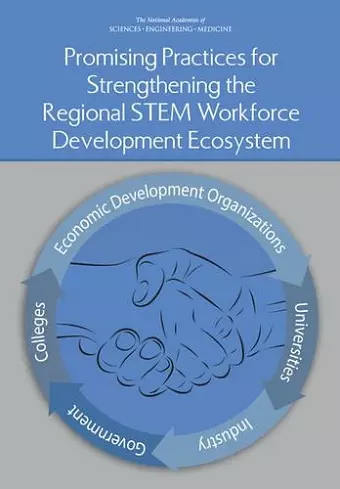Promising Practices for Strengthening the Regional STEM Workforce Development Ecosystem
Board on Higher Education and Workforce author Policy and Global Affairs author National Academies of Sciences, Engineering, and Medicine author Committee on Improving Higher Education's Responsiveness to STEM Workforce Needs: Identifying Analytical Tools and Regional Best Practices author
Format:Paperback
Publisher:National Academies Press
Published:12th Mar '16
Currently unavailable, and unfortunately no date known when it will be back

U.S. strength in science, technology, engineering, and mathematics (STEM) disciplines has formed the basis of innovations, technologies, and industries that have spurred the nation's economic growth throughout the last 150 years. Universities are essential to the creation and transfer of new knowledge that drives innovation. This knowledge moves out of the university and into broader society in several ways – through highly skilled graduates (i.e. human capital); academic publications; and the creation of new products, industries, and companies via the commercialization of scientific breakthroughs. Despite this, our understanding of how universities receive, interpret, and respond to industry signaling demands for STEM-trained workers is far from complete.
Promising Practices for Strengthening the Regional STEM Workforce Development Ecosystem reviews the extent to which universities and employers in five metropolitan communities (Phoenix, Arizona; Cleveland, Ohio; Montgomery, Alabama; Los Angeles, California; and Fargo, North Dakota) collaborate successfully to align curricula, labs, and other undergraduate educational experiences with current and prospective regional STEM workforce needs. This report focuses on how to create the kind of university-industry collaboration that promotes higher quality college and university course offerings, lab activities, applied learning experiences, work-based learning programs, and other activities that enable students to acquire knowledge, skills, and attributes they need to be successful in the STEM workforce. The recommendations and findings presented will be most relevant to educators, policy makers, and industry leaders.
Table of Contents- Front Matter
- Summary
- 1 Introduction and Overview
- 2 Project Context and Background
- 3 Background on the Selected Regions
- 4 Lessons Learned and Analysis
- 5 Findings and Recommendations
- Appendix A: Biographical Information of Committee and Staff
- Appendix B: Committee Meeting Agendas
- Appendix C: Regional Workshop Agendas and Participants Lists
- Appendix D: Supplemental Material on K-12 Educationand Its Role in the Regional STEM Workforce Development Ecosystem <
ISBN: 9780309391115
Dimensions: unknown
Weight: unknown
122 pages